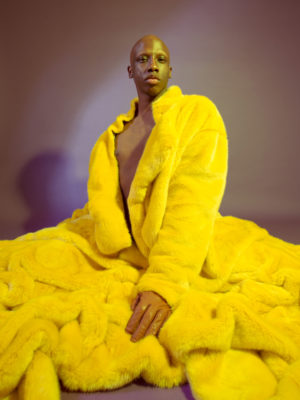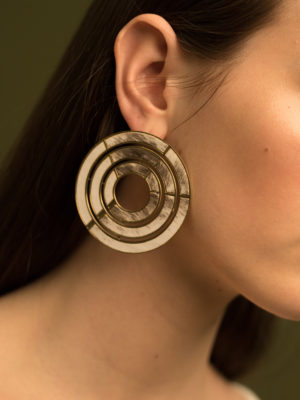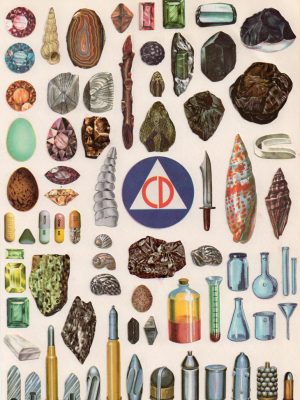
Extracted from hell, the gemstone came to symbolize hell, and took on its fundamental characteristic; the inhuman. Like stone (and stone provided a large amount of gems), it was associated above all with hardness; stone has always stood for the very essence of things, for the irremediable inanimate object; stone is neither life nor death, it represents the inert, the stubbornness of the thing to be nothing but itself; it is infinitely unchanging. It follows then, that stone is pitiless; whereas fire is cruel, and water crafty, stone is the despair of that which had never lived and will never do so, of that which obstinately resists all forms of life. Through the ages the gemstone extracted from its mineral origins its primary symbolic power: that of announcing an order as inflexible as that of things.
Nevertheless, humanity’s poetic imagination was able to conceive of stone that were made to wear out, noble, venerable stones, which grew old and so were, despite everything alive. As for the quintessential stone, the diamond, it is beyond time: never wearing, incorruptible, its limpidness forms the moral image of the most deadly of virtues – purity; in terms of substance, the diamond is pure, clean, almost aseptic; but whereas there are some purities that are tender, fragile (water for example), there are others that are sterile, cold, steely; for purity is life, but it can also be, by contrast, infertility, and the diamond is like the sterile son emerging from the deepest point of the earth, non-productive, incapable of rotting down, hence incapable of becoming the source of new life.
And yet, it seduces; hard and limpid, the diamond has a third symbolic quality: it glistens. Here it is incorporated into a new magical and poetic domain, that of the paradoxical substance, both lit up and stone cold: it is nothing but fire and yet nothing but ice.
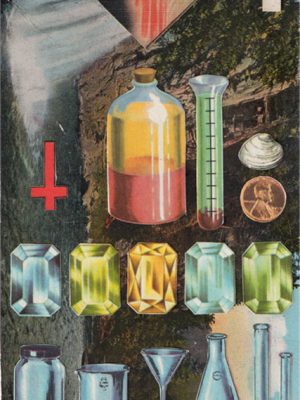
This cold fire, this sharp, shinning object which is nevertheless silent, what a symbol for the whole world of vanities, of seductions devoid of content, if pleasure devoid of sincerity! For centuries, Christians humanity felt deeply (much more than we do today) the opposition between the world and solitude; thanks to its fire-like sparkle and its coldness, the diamond was this world, this abhorrent and fascinating order of ambition, flattery and disappointment, condemned by so many of our moralists – perhaps in order better to describe it.
And about gold, which was also used to make gemstone? Though originating in the earth and in hell, arriving first as ore or as a nugget, gold is a substance more intellectual than symbolic; it holds a fascination only within certain mercantile economies; it has no, or very little, poetic reality; it is only ever mentioned so as to show how this most mediocre of substances (a dull, yellow metal) clashes with the importance of its effects. But as a sign, what power it has! And it is precisely the sign per excellence, the sign of all the signs; it is absolute value, invested with all powers including those once held by magic: is it not able to appropriate everything, goods and virtue, lives and bodies? It is not to convert everything into its opposite, to lower and to elevate, to demean and to glorify? The all: owing to the fact that gold very quickly stopped being convertible or useful and so removed itself from any practical application, pure gold, whose usefulness was almost entirely self-referential, became superlative gold, absolute richness – here the gemstone becomes the very concept of price; it is worn like an idea, that of a terrific power, for it is enough to be seen for this power to be demonstrated.
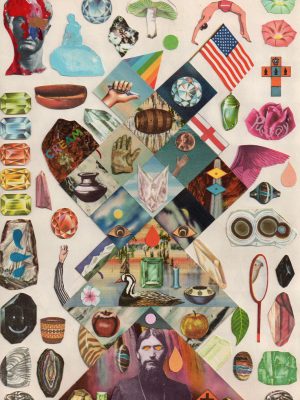
There is no doubt that, fundamentally, the gemstone was a sign of superpower, that is of virility, and remained so for very long time (after all, it is only recently and under the puritan influenced of Quaker clothing, which is the origin of men’s clothing today, that men stopped wearing gemstone). So why it has been associated so constantly with woman, with her powers and her evil spells? It is because the husband very quickly delegated to his wife the job of showing off his wealth (certain sociologists use this to explain the origin of fashion): the wife provides poetic proof of wealth and power of the husband. Except that, as always with human society, a simple pattern is quickly invested with unexpected meanings, symbols and effects. Thus the primitive showing-off of wealth has been invaded by a whole mythology of woman: this mythology remains infernal, because woman give everything to own gemstones, and man would give everything to own that very woman who wears the gemstones that she has sold herself for; with gemstones as the link, woman gives herself up to the Devil, the husband to the woman, who has herself become a precious, hard stone: and we must not assume that symbolism of this sort, which is both prosaic, spiritual and, after all, naïve, belongs only to the barbarous periods in Western history. The whole of the Second Empire in France (1852-1871) for example was intoxicated and panic-stricken by the power of gemstones, by this capacity to induce human Evil, which for so long had been almost a physical property of diamond and gold: Zola’s Nana really is the grandiose and angry cry of a society destroying itself, or one might even say devouring itself, in two ways; woman is both a man-eater and a diamond-eater.
Such a mythology has not completely disappeared from our times: there are still fine jewellers, a world market in diamonds and thefts of famous gemstones. But their infernal aspect is clearly on the decline. First, because the mythology of woman has changed: in the novel, in films, woman is less and less the femme fatale, no longer the destroyer of men; she can no longer be essentialized, stopped from existing or made into a precious and dangerous object; she has rejoined the human race. And also gemstones, the great mythical gemstones, are barely worn nowadays; they are of historical value, only, sterilized, embalmed and kept away from female body, condemned to sit safe. In short, fashion – need I say more? – no longer speaks of the gemstone but only of jewellery.
Now fashion, as we know, is a language: though it, through the system of signs it sets up, no matter how fragile this may seem, our society – and not just that of women – exhibits, communicates its being, says what it thinks of the world: so, just as the gemstone basically expressed essentially theological nature of ancient society, so jewellery today, as seen in shops and in fashion magazines, merely follows, expresses and signifies our times – having originated in the ancestral world of the damned, the piece of jewellery has in one word become secularized.
First and foremost this secularization has visibly affected the very substance of jewellery; it is no longer made from just stone or metal, but also fragile or soft materials such as glass or wood. Furthermore, jewellery is no longer routinely given the job of showing off a prize that is, so to speak, inhuman: you see jewellery made of common metal, or inexpensive glass: and when jewellery imitates some precious substance, gold or pearls, it is shameless; the copy, now way of being rich on the cheap – it is quite open about itself, makes no attempt to deceive, only retaining the aesthetic qualities of the material it is imitating. In short, there has been a widespread liberation of jewellery; its definition is widening, it is now an object that is free, if one can say this, from prejudices; multiform, multisubstance, to be used in an infinite variety of ways, it is now no longer subservient to the law of highest price nor to the that of being used only one way, such as for a party or sacred occasion: jewellery has become democratic.
Of course, this democratization does not escape from new ways of conferring value. As long as wealth regulated the rarity of gemstones, the latter could judged by nothing but its price (that of its substance and of the work out into it); but once just about anyone could procure whatever they wanted, as soon as the work of art became a product, there had to be a way, in our democratic, but still differentiated, societies, of subjecting jewellery to another form of discrimination: and this is taste, of which fashion is precisely the judge and the keeper. So today we have jewellery of bad taste; and, rather paradoxically what defines bad taste in a piece of jewellery is curiously that which was once the very sign of its prestige and of its magical qualities: namely its highest price; not only is jewellery that is too rich or too heavy now discredited but conversely, for expensive jewellery to have good taste, its richness must be discreet, sober, visible certainly but only to those in the know.
So what counts as good taste in jewellery today? Quite simply this: no matter how little it costs, the piece of jewellery must be thought about in relation to the whole outfit it accompanies, it must be subjected to that essential functional value which is that of style. What is new, if you like, is that the piece of jewellery is no longer on its own; it is one term in a set of links that goes from the body to the clothing, to the accessory and includes the circumstances for which the whole outfit is being worn; it is part of an ensemble, and this ensemble is no longer necessarily ceremonial: taste can be everything, at work, in the country, in the morning, in the winter, and the piece of jewellery follows suits; it is no longer a singular, dazzling, magical object, conceived as a way of ornamenting and thus making woman look at her best; it is now humble and more active, an element of clothing which enters into an equal relationship with a material, with a particular cut or with another accessory.
So it is precisely its smallest, its finished look, its very substance as the opposite of the fluidity of fabrics, that makes the piece of jewellery part of fashion and it has become almost like the soul in the general economy of clothing: that is, the detail. It was inevitable that, in making taste into the product of a subtle set of functions, fashion would give more and more weight to the simple presence of the element no matter how small and without regard for its physical importance; this gives rise to the highest value in today’s fashion being placed on anything insignificant in size but which is able to modify, harmonize, animate the structure of a set of clothes, and it is called precisely (but from now with a lot of respect) a next-to-nothing. The piece of jewellery is a next-to-nothing, but out of this next-to-nothing comes great energy. Often inexpensive, sold in simple ‘boutiques’ and no longer in the temples of jewellery shops, available in a variety of materials, free styles (often including the exotic even), in short depreciated in the true sense of the word, in its physical state, the most modest piece of jewellery remains the vital element in getting dressed, because it underlines the desire for order, for composition, for intelligence. Analogous to those half-chemical, half-magical, substances which act all the more forcefully by virtue of their infinitesimal size, the piece of jewellery reigns over clothing not because it is absolutely precious but because it plays a crucial role in making clothing mean something. It is meaning in a style which now becomes precious and this meaning depends, not on each element, but on the link between them and in this link it is the detached tem (a pocket, a flower, a scarf, a piece of jewellery) that holds the ultimate power of signification. This is true that is not only analytical but also poetic: this great journey across centuries and across societies, from the gemstone to jewellery, it is the very same itinerary that has transformed the cold, luxurious stones in the Baudelairian universe into those trinkets, pieces of jewellery and next-to-nothing in which Mallarme could then enclose a whole metaphysics of the new power of Man to make the tiniest of thing with meaning.
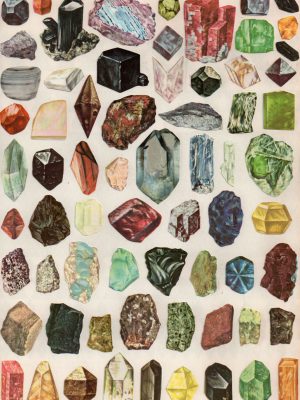
The book Language of Fashion by Roland Barthes was first published in France, 2004, by Editions du Seuill
The article From Gemstones to Jewellery was first published in Jardin des Arts, 77 (April), 1961; Oeuvres complétes vol. 1, 911-14.
Illustrations and collages by AMBER IBARRECHE.

